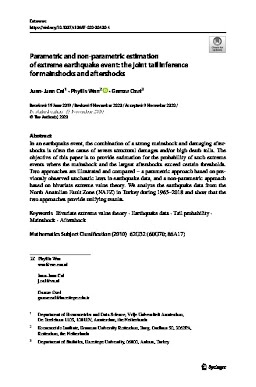2020
Parametric and non-parametric estimation of extreme earthquake event: the joint tail inference for mainshocks and aftershocks
Publication
Publication
Extremes: statistical theory and applications in science, engineering and economics
In an earthquake event, the combination of a strong mainshock and damaging aftershocks is often the cause of severe structural damages and/or high death tolls. The objective of this paper is to provide estimation for the probability of such extreme events where the mainshock and the largest aftershocks exceed certain thresholds. Two approaches are illustrated and compared – a parametric approach based on previously observed stochastic laws in earthquake data, and a non-parametric approach based on bivariate extreme value theory. We analyze the earthquake data from the North Anatolian Fault Zone (NAFZ) in Turkey during 1965–2018 and show that the two approaches provide unifying results.
| Additional Metadata | |
|---|---|
| , , , , | |
| doi.org/10.1007/s10687-020-00400-4, hdl.handle.net/1765/131750 | |
| Extremes: statistical theory and applications in science, engineering and economics | |
| Organisation | Department of Econometrics |
|
Cai, J.-J., Wan, P. (Phyllis), & Ozel, G. (Gamze). (2020). Parametric and non-parametric estimation of extreme earthquake event: the joint tail inference for mainshocks and aftershocks. Extremes: statistical theory and applications in science, engineering and economics. doi:10.1007/s10687-020-00400-4 |
|

